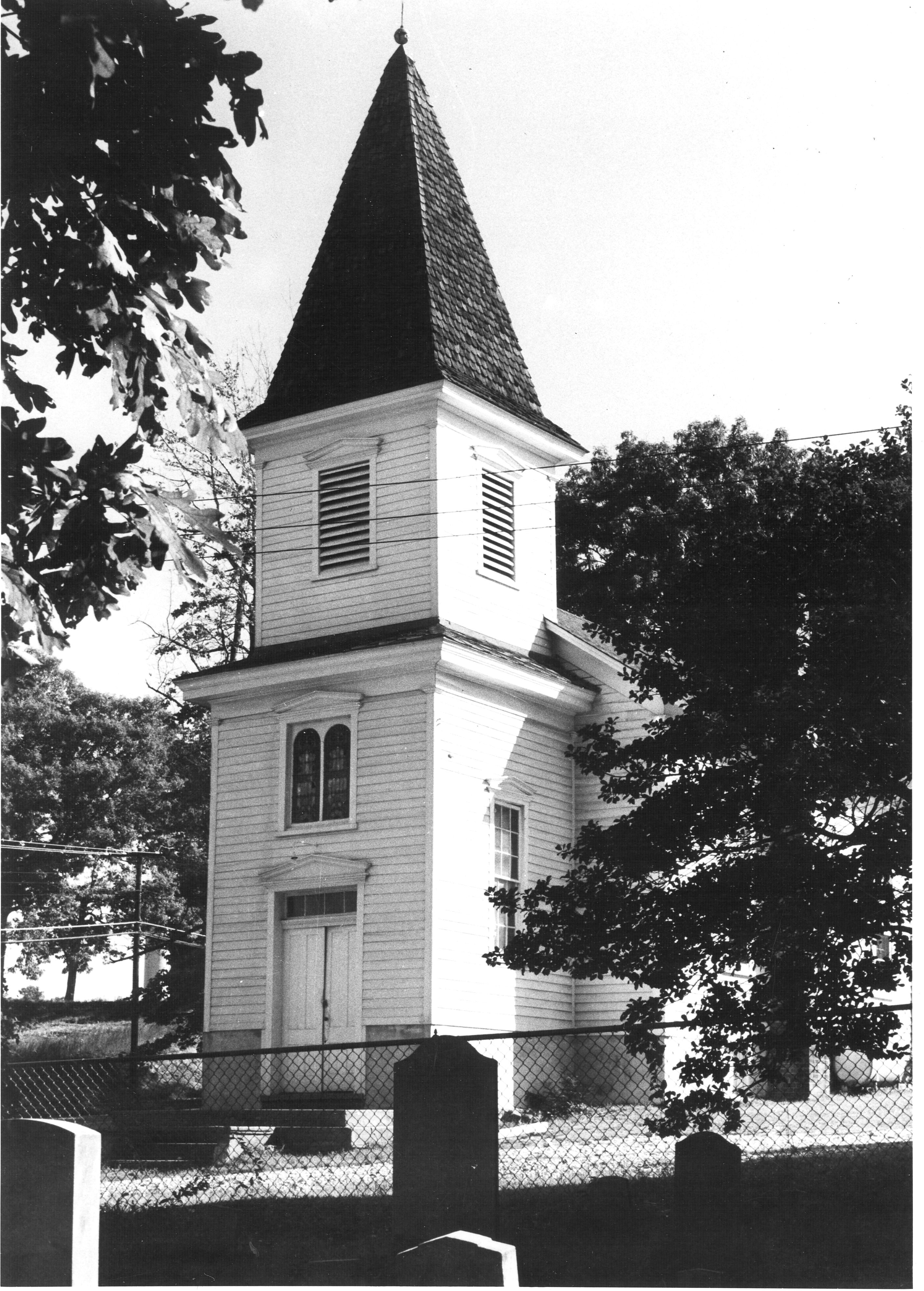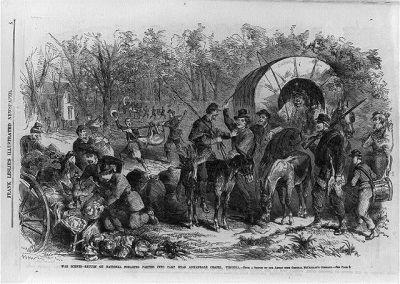
Annandale United Methodist Church
The True Story
By M. Callahan

A well-known Annandale landmark, recognized by young and old, is the Historic White Church on Columbia Pike at Gallows Road. Although various stories have emerged over the past decade about the history of this beloved building and its predecessor, what is the true story? The original Methodist Church was built in 1846 on land deeded by William Garges. Early church trustees were Alfred Moss, owner of Green Spring Manor & Farm, Ambrose Cock, Isaac Newcomb, Thomas Crux, James Kidwell, John Dulin, Hiram Powell, and Henry Padgett.
Popular lore tells that the original church was used as a Union hospital during the Civil War, although no documentation can be found to substantiate the claim. It is known from an 1862 engraving in Frank Leslie's Illustrated Newspaper that Union Troops did encamp on the grounds following the 2nd Battle of Bull Run. During that winter, they partially destroyed the building by removing many wood planks for firewood.
Supposedly, two years later, the church was burnt to the ground by Union troops. The tale has since grown to include the burning of the village, which consisted of a few buildings centered at the crossroads of Little River and Columbia Pike; nowhere near the church; and never reported to have been damaged by fire. Legend claims that the order was carried out by Sgt. Elhanan Wakefield who, after the Civil War, atoned for this tragedy by helping to rebuild the church. (Charming story; but not true.)
One, and only one article reports this tale. No sources were cited in this internet rendition, nor do all the claims match-up with contemporary evidence. It is known that Wakefield served in the Union Army and certainly came through Annandale during his service, while stationed primarily in Vienna at the time in question. It is known that after making his way from a hospital in Annapolis to Annandale, being gravely wounded in the Shenandoah battle of Tom’s Brook, and following his discharge from the army on March 24, 1865, he was nursed in Annandale by his bride-to-be, Mary Rebecca Tennison and her mother.
No actual interview or newspaper report can be found documenting that a raid even occurred, or Wakefield’s role, in spite of the fact that he continued to live in Annandale for 56 years following the War, and was often interviewed by various local papers, and gave frequent lectures on the war. His son, Lowell Tennyson Wakefield, Senior, also lived locally until his death on April 4, 1978, and was interviewed by the local press. A frank and charming gentleman, he never mentioned a raid on the church; let alone any involvement on the part of his father. Without documentation, or a single eye witness reporting the incident, this quite new rendition must be considered simply fanciful storytelling.
The real story is that in the fall of 1863, the church was occupied under the orders of General Blenker and Colonel Lowell, USA. Initially, they used the church as temporary quarters before dismantling it, and utilizing the materials and contents to construct winter quarters. (1) The building had fallen into disrepair since the local congregation had been conducting services in the home of a local resident which was preferable to interacting with Union Troops encamped on the church grounds. By 1864, reference is made to the "Old" Annandale church, referring more to the site than the building.
The Trustees of the Methodist Episcopal Church of Annandale, VA (as it was then known) made a claim for compensation to the Committee on Claims/Court of Claims, March 3, 1887, stating that they were entitled due to the,
“use, occupation, and appropriation of material alleged to have been taken by the United States for their use during the late Civil War." The court ruled, “Be it enacted by the Senate and House of Representatives of the United States of America in Congress assembled, That the Secretary of the Treasury be, and he is hereby, authorized and directed to pay, out of any money in the Treasury not otherwise appropriated, to the trustees of the Methodist Episcopal Church of Annandale, Virginia, the sum of $2,500 for use occupation, and destruction of their church property by the military forces of the United States during the late Civil War." (1)
However, no money was forthcoming, most likely because the US Treasury was running dry, and the church still needed to prove, “loyalty to the Union.” The trustees again petitioned the Senate and Congress in 1914 as follows:
“That during the fall of 1863 the military forces of the United States, under command of Gen Blenker and Col. Lowell, took possession of the church building of the Methodist Episcopal Church south of Annandale, Fairfax County, VA., and used and occupied the same for quarters for a period and then removed the said building, appropriating the material therein to the use of the United States Army; that said building at the time the said forces took possession as aforesaid was reasonably worth the sum of $2,500, for which no payment has been made; that said Methodist Church, as a church, was loyal to the Government of the United States throughout the Civil War.” (1)
Having established that the United States Army was responsible for the appropriation of the church (materials) and that the church was loyal to the Union, the court ruled on June 1, 1914 that an award was to be paid. They assessed the value of the building to be $850.00.
During the Civil War, Annandale formed part of the protective perimeter surrounding Washington; positioned squarely behind Union lines the entire war, except for a few months in late 1861, when both sides swept in and out of the community engaging in skirmishes without establishing a foothold. Small scale raids by Confederates foraging (a sanitized term for thieving) food, livestock, grain, and wood, continued through 1864. The Union soldiers, as an occupying force, requisitioned much the same supplies, depriving local residents of their property and means of survival. Farmers eventually gave-up replacing any fencing since it would be stolen by Confederate, or Union soldiers, as soon as reinstalled, and there was no livestock left to protect within the fence. The soldiers used the fence materials for firewood, tent poles, and pit pikes, while some residents, in despair, moved away for the duration of the war
A particularly sad loss to the area, and much to the horror of the property owner, Union patrols clear-cut over 4,000 acres of hardwood forest on the Ravensworth Plantation, explaining that it required fewer soldiers to guard the cutting teams in a single location. Additionally, Ravensworth was conveniently close to a rail line making for easy transport of the lumber. After the war, Anna Marie Fitzhugh, proprietress of Ravensworth, was denied her claim to any compensation for this vast amount of timber, since she was also required to provide proof that she had always remained loyal to the Union. Aunt of Mary Ann Custis Lee, wife of Robert E. Lee, she was too often overheard by her servants denigrating her Yankee occupiers to pass this caveat. (2)
It is known that Wakefield did contribute his carpentry skills to build Wakefield Chapel, and only Wakefield Chapel, and did preach from that pulpit. Both he and his wife, Mary Rebecca Tennison of Annandale (married Sept. 5, 1865), are buried in the cemetery of the Annandale Methodist Church which is the church she attended growing up, and since she passed first, she was buried with her parents, and joined later by her husband. The cemetery registry lists: Rev. Elhanan W. Wakefield: 1834-1920 (2nd Mass Calvary 1863-1865), Mary Tennison Wakefield: 1842-1907 wife of Rev. E.W. Wakefield, and Harry Harold Wakefield: May 3, 1886-Oct. 5, 1959 son of Rev. Elhanan Wakefield.
The small white frame and clapboard church seen today was actually built by Thomas Walker, not Wakefield, between 1868 and 1870, slightly north and east of the original structure with a balcony for African American worshipers. By 1880 the first public school in Annandale was in the basement of this building. In 1907, at the cost of $50, the belfry, pulpit and vestibule were added by Rev. Lowell Wakefield and John Cock. A year later the Ladies Aid Society donated the heavy bell for the steeple (now on display outside the building). From then until 1923, it became  Annandale’s only fire alarm, and last tolled on VJ Day 1945. It was removed 12 years later when the aging louvered belfry could no longer support the weight. In 1912 the small white building beside this chapel was built. It has served as everything from a community hall with a stage for performances and presentations, to a scout hall for Boy Scout Troop 150
Annandale’s only fire alarm, and last tolled on VJ Day 1945. It was removed 12 years later when the aging louvered belfry could no longer support the weight. In 1912 the small white building beside this chapel was built. It has served as everything from a community hall with a stage for performances and presentations, to a scout hall for Boy Scout Troop 150
In 1946, one hundred years after the construction of the original building, the large brick church at the top of the hill was dedicated on land donated by Mr. and Mrs. Vernon Lynch. Additions were added in 1956 and again in 1966. Adjacent to the church is a small cemetery containing over 100 headstones. The oldest gravestone is that of Susan Fretz Garges who died on September 11, 1828. She and others were originally buried in family cemeteries and then re-interred in this church ground once the church was built. Twice the current Little White Church has required major renovations. The first occurred in 1973 due to general deterioration. The second, a more significant renovation, took place in 2003 when a car smashed into the building.
The Chamber extends heartfelt gratitude to the United Methodist Church and Pastor Clarence Brown for allowing the annual Annandale Parade to gather in their parking lot and for their effervescent community spirit. Bring your family & neighbors to watch the fun while celebrating ANNANDALE, on the fourth Saturday of each October.
Reproduction of this article, in whole or in part, requires permission from the author.(1) Congressional Court of Claims, No. 13626, United States Congress, Congressional Edition, Vol. 6597, Document 519, Trustees of the Methodist Episcopal Church, South, of Annandale, VA,
(2) Mauro,Charles: The Civil War in Fairfax County, (Charleston, SC: The History Press.2006), 36. [This is an excellent historical capsulation of local Civil War history. It is well written & exhaustively researched; highly recommended.]
The church is located at 6935 Columbia Pike, Annandale, VA 22003
Copyright 2012 Annandale Chamber of Commerce. All rights reserved. Privacy Policy
